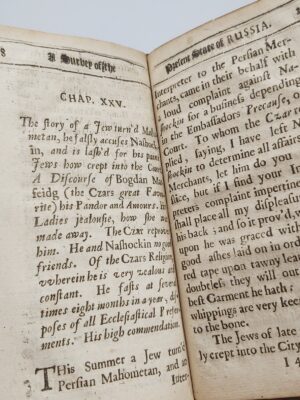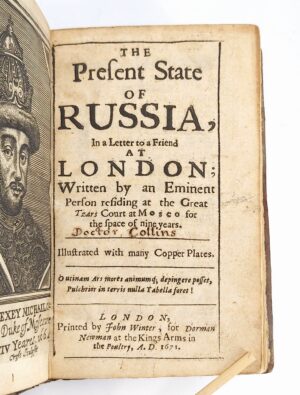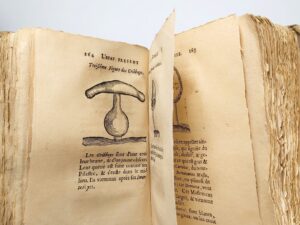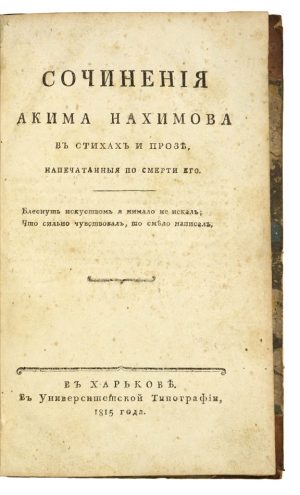Our Notes & References
From the Tsar’s character to Beluga caviar and Russian mushrooms: a wide-ranging, very personal and entertaining panorama of Russia before Peter the Great.
First edition of one of the early European accounts of Russia, “one of the few English works […] based on actual knowledge of life in seventeenth-century Russia” (Cross).
A doctor of medicine, trained at Cambridge and Oxford, Samuel Collins (1619-1670) was invited to Russia to work as a personal physician to tsar Alexis I, the father of Peter the Great, in 1660-66, and remained in Moscow until 1669. The notes he took during the stay, combined with the letters to his friend Robert Boyle, were published posthumously by an anonymous friend of his, in this 1671 first edition.
This is Collins’ only book, yet his name is not mentioned, with the sole reference being “Dr C.” in the note “To the Reader”. In the mid-19th century, Adelung erroneously claimed that the first edition of this book appeared in 1667; this error was repeated in many Russian studies, although the alleged 1667 edition is unknown to any Western European bibliographer, and it is logistically impossible “that the edition of 1671 could have been preceded by an earlier one” (Loewenson).
As the tsar’s physician, Collins was able to acquire information “not only of tsar Alexis himself, but also of prominent people at his court, and in the first place of the eminent statesman Ordyn-Nashchokin” (Loewenson). This lively account of his stay contains valuable and original information about the tsar’s character and habits, the court life, judicial system (with a note on exiles and tortures), and several legends about tsar Ivan IV the Terrible. The book also includes sections detailing the tsar Alexis’ exclusive control over Siberian fur and Astrakhan caviar trade, alongside depictions of Moscow, Siberia, the Caucasus, Crimea, and the steppe, joined by a separate and very unusual, “most interesting” (Whittaker) chapter on Russian mycology with two engravings of mushrooms.
Famous for its highly personal, straightforward, and sometimes gruesome or caricatural style, Collins’ book has sometimes been severely judged: “this book… suffered in part from the improbable anecdotes inserted for the entertainment of the reader, probably by the editors of the book” (ODNB). Other scholars however state the opposite: Collins “has some curious remarks about the life and manners of the 17th century, which are confirmed in Russian folklore […] His information is quite peculiar and, to the author’s credit, does not contain fantastical anecdotes” (Shokarev, our translation): he leaves insightful details about Russian peoples’ everyday life, clothes, food, strong inclination to drinking, music and customs, mentioning wedding and funeral rites, and the festivals and traditions of the Orthodox year. The doctor’s observations also address local sanitary conditions and the spread of diseases – at the same time approving the execution of money forgers by pouring molten tin into the mouth, and the burying alive of women who murder their husbands. The last 8 pages are a bookseller’s catalogue of D. Newman.
The seven copper engravings include a portrait of tsar Alexis as a young man, which “may have been taken from life and therefore may be among the earliest depictions of a Russia head of state” (Whittaker). They also show a fantastical-looking Russian five-domed Church with semiclassical lower tiers, a similarly styled bell tower of the Moscow Kremlin, Orthodox ways of blessing, and Slavonic alphabet. The anonymous French edition that followed (Paris, 1679) had these plates in woodcuts; the first Russian translation (from French) appeared only in excerpts in Russkii vestnik [Russian Messenger] in 1841 since the book, often negative about Russians, was banned before that. A separate edition with the entire text translated appeared in 1846.
Not to confuse this Samuel Collins with his two contemporaries: Samuel Collins (1618–1710), a personal physician to Charles II of England and author of A System of Anatomy, and Samuel Collins (1617–1685), a physician and registrar at Oxford University.
Provenance
Prof. Philip Longworth (1933-2021, historian and writer, esp. on Russian history).
Bibliography
ESTC R17430; Cox I, 190 (“very entertaining account”); Cross, ‘In the Lands of the Romanovs’ A6; Cross, A. G. “British Knowledge of Russian Culture (1698-1801)”. Canadian-American Slavic Studies, 13, No. 4 (Winter 1979), pp. 412-35.
Loewenson, Leo. “The Works of Robert Boyle and ‘The Present State of Russia’ by Samuel Collins (1671)”. The Slavonic and East European Review, vol. 33, no. 81, 1955, pp. 470–85.
Shokarev S. “Samuel Kollins. Nyneshnee sostoianie Rossii. Rossiia v tsarstvovanie Alekseia Mikhailovicha glazami inostrantsev”. Utverzhdenie dinastii, Moskva, Fond Dubrova, 1997.
Whittaker, Russia Engages the World, NYPL, p. 18-19 (with full-p. illustration of the tsar’s portrait).
Physical Description
Engraved portrait frontispiece, title, [iv] ‘To the Reader’, [xvi] detailed table of contents, 141, and pp. postface and publisher’s catalogue, with 6 engraved plates.
Binding
Contemporary mottled calf.
Condition
Rebacked to style with spine with raised bands, gilt in compartments, red label lettered in gilt; frontispiece with lower left corner torn away and repaired, not affecting text or image, postface leaf a bit frayed at lower edge, small recent pencil markings in blank margins, a couple of old ink annotations, incl. one to title giving the author’s name.





























![Image for Illiustrirovannaia khronika voiny [The Illustrated Chronicle of War], Skt. Peterburg, 1877-78. First edition, in publisher's binding. #1](https://www.pyrarebooks.com/wp-content/uploads/2023/02/1072-300x263.jpg)

![Image for ASHIK, A. Vosporskoe tsarstvo [Bosphorus Kingdom], first edition, Odessa, 1848-9. #2](https://www.pyrarebooks.com/wp-content/uploads/2024/02/1921_1-300x332.jpg)
